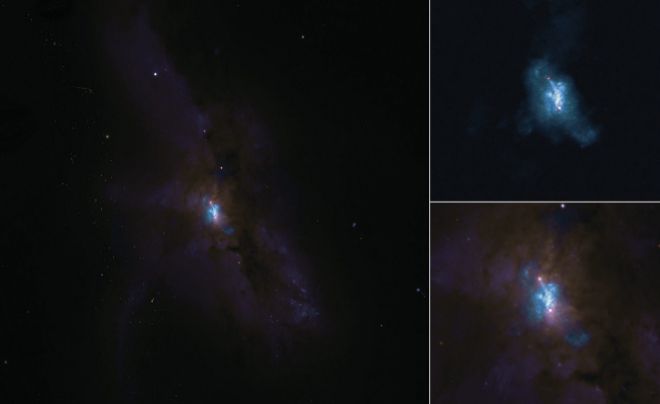- M87.A black hole turned into a pop icon
- Gravitational waves Second detection of the cosmic fusion in which gold is produced
- Chile: In the heart of ALMA, the largest radio telescope in the world
In the Ophiuchus constellation, 400 million light years away from Earth, two galaxies have merged into another larger galaxy that has been named NGC 6240 . It is a chaotic and very complex galaxy, according to astronomers who have been observing how it is forming for some time.
Now, thanks to the ALMA radio telescope that the European Southern Observatory (ESO) has in the Chilean Atacama Desert, they have been able to observe in great detail the material around the two supermassive black holes of those two galaxies. With the new observations, images have been obtained with a much higher resolution than they had until now. Observing the gas and dust surrounding these cosmic monsters also helps them determine their mass.
In fact, as explained by Anne Medling, a researcher at the University of Toledo (Ohio, USA), the images obtained with the ALMA radio telescope, located at an altitude of 5,000 meters, have revealed that the mass of the two black holes is less than the one they had previously determined using mathematical models.
This new research on the enigmatic black holes has been presented during the congress that the American Astronomical Society is celebrating in Honolulu (Hawaii) and will be published in two scientific articles in the Astrophysical Journal Letters .
Most of the observed gas is located in the region between the two black holes, and they estimate that it is expelled at speeds of up to 500 kilometers per second. One aspect that has surprised them is that the gas is closer to the black hole than they expected. His hypothesis is that over time, the gas will end up being swallowed by the hole or it will be expelled at high speeds.
Galactic evolution
On the other hand, scientists who have analyzed the images of ALMA say they have not found evidence that there is a third black hole in that region of the sky, as another team of scientists had suggested.
"This galaxy is so complex that without these detailed images we would not have been able to know what is inside," said Loreto Barco-Muñoz, of the Charlottesville Radio Astronomy Observatory (Virginia, USA), which highlights that this allows them to study the evolution of These galaxies " Within several hundred million years, this galaxy will look totally different, " he adds.
The merger between these two galaxies is not over . The process, astronomers say, continues and it is likely that the two supermassive black holes they contain end up merging likewise and becoming a single black hole.
According to the criteria of The Trust Project
Know more- Science and Health
- science
ScienceGreta Thunberg, chosen by Nature magazine as one of the 10 relevant people in science in 2019
ScienceA piece of prehistoric chewing gum reveals its consumer's DNA
Climate crisis Teresa Ribera: "We have 10 years left to avoid the climate catastrophe"

